Jalal Jebelli1, Chandra Madramootoo2, Gebremedihen Tesfaye Gebru3
1Small-Scale & Micro Irrigation Support Project, Kedamay Woyane Subcity, Tigray, Ethiopia
2Small-Scale & Micro Irrigation Support Project, Addis Ababa, Ethiopia
3Environmental Protection, Land Use and Land Administration Agency, Tigray, Ethiopia
Correspondence to: Jalal Jebelli, Small-Scale & Micro Irrigation Support Project, Kedamay Woyane Subcity, Tigray, Ethiopia.
| Email: |  |
Copyright © 2017 Scientific & Academic Publishing. All Rights Reserved.
This work is licensed under the Creative Commons Attribution International License (CC BY).
http://creativecommons.org/licenses/by/4.0/

Abstract
One of the primary requirements during the initial stages of sustainable development of a new irrigation scheme is the environmental and social impact assessment (ESIA) study. This should take place as early as in the project development stage and at the latest during the feasibility study where the main feature of the project has not firmed up yet. The principal objective of this study is to develop a simple technique to assess and analyze the environmental and social impact of a typical small-scale irrigation scheme. The technique has been developed and applied to analyze the environmental impacts under different temporal and spatial conditions dominant during the life cycle of Mekabo small-scale irrigation scheme currently under development in Tigray region in Ethiopia. The adopted technique includes a two dimensional matrix inspired by Leopold approach. Fourteen key impact factors have been singled out from a wider list of less significant potential factors. The magnitude and significance of each impact factor has been graded separately using expert judgment and the indices developed for this purpose. The scores were then compared against acceptable and rejecting thresholds for final conclusion. Accordingly, some mitigation measures were also recommended to reduce the negative environmental impact of the proposed scheme. This paper will discuss the processes that led to the development of a simplified environmental impact assessment approach for Mekabo small-scale irrigation scheme in Ethiopia.
Keywords:
Small-scale irrigation schemes, Environmental and social impact assessment, Leopold matrix approach, Mitigation measures
Cite this paper: Jalal Jebelli, Chandra Madramootoo, Gebremedihen Tesfaye Gebru, A Simplified Matrix Approach to Perform Environmental Impact Assessment of Small-scale Irrigation Schemes: An Application to Mekabo Scheme in Tigray, Ethiopia, American Journal of Environmental Engineering, Vol. 7 No. 2, 2017, pp. 21-34. doi: 10.5923/j.ajee.20170702.01.
1. Introduction
Sustainable development of small-scale irrigation (SSI) schemes has been the foundation of food security programs supported by the government of Ethiopia and some external donors since the 1980s. One of the primary requirements during the initial stages of development of a new irrigation scheme is the environmental and social impact assessment (ESIA). This should take place as early as in the project development stage, and at the latest during the feasibility study where the main feature of the project has not firmed up yet. However, in many circumstances an ESIA is often undertaken in the later stages of a project and regarded as a process, which would produce evidence as why the project should be allowed [1]. The ESIA is a tool designed to identify and predict the impact of a project on bio-geophysical environment and to provide solutions to tackle, abate, or mitigate the negative and reversible consequences that are always much more expensive to correct after their occurrence. Therefore, when the project design is complete the final version of ESIA should be produced and submitted [2]. Various techniques have been employed by researchers and practitioners to assess the environmental and social impacts of irrigation schemes. Dougherty et al. [3] have discussed the problems and the appropriate mitigations for environmental impact of irrigation systems. Ulsido et al. [4] have carried out a research in the Rift Valley Lakes Basin in Ethiopia to compare the relative environmental impact of some local irrigation schemes. They employed ad-hock technique to assess the impact at the community level; however, the checklists, matrices, and rule-based analysis have been used in the rest of their study. FAO [2] has supported the use of Leopold matrix to assess the environmental impact of pulp and paper industry. Josimovic et al. [5] have used the Leopold matrix to assess the environmental impact of wind farms in Serbia.The principal objective of this study is to develop a simple technique based on the lessons learned from the literature in order to assess the environmental impact of a typical SSI scheme. Accordingly, a simplified approach was adopted using the Leopold matrix method. This approach was then used to assess and weigh the impact of various environmental factors under different temporal and spatial conditions dominant in the entire life cycle of Mekabo SSI scheme currently under development in the Tigray region of Ethiopia. The background information for the assessment was collected from field observations and technical interactions with the local experts. According to the results of assessment, some mitigation measures were also recommended. This paper will discuss the processes that led to the development of a simplified matrix approach for the environmental and social impact assessment of Mekabo SSI scheme.
2. Materials and Methods
2.1. Interface between Small-Scale Irrigation Schemes and the Environmental
There is relatively good consensus in the literature among researchers and practitioners that the environmental impact assessment should mainly focus on the key components of the environment such as physical, natural, economic, social, cultural, political, urban, rural, industry, and tourism [2, 3, 6, 7]. However, among the above-mentioned environmental elements the first four items is believed to be the most significant ones. Implementation of a SSI scheme, as demonstrated in Figure 1 would trigger explicit interactions with the major components of the environment as discussed in the follow section.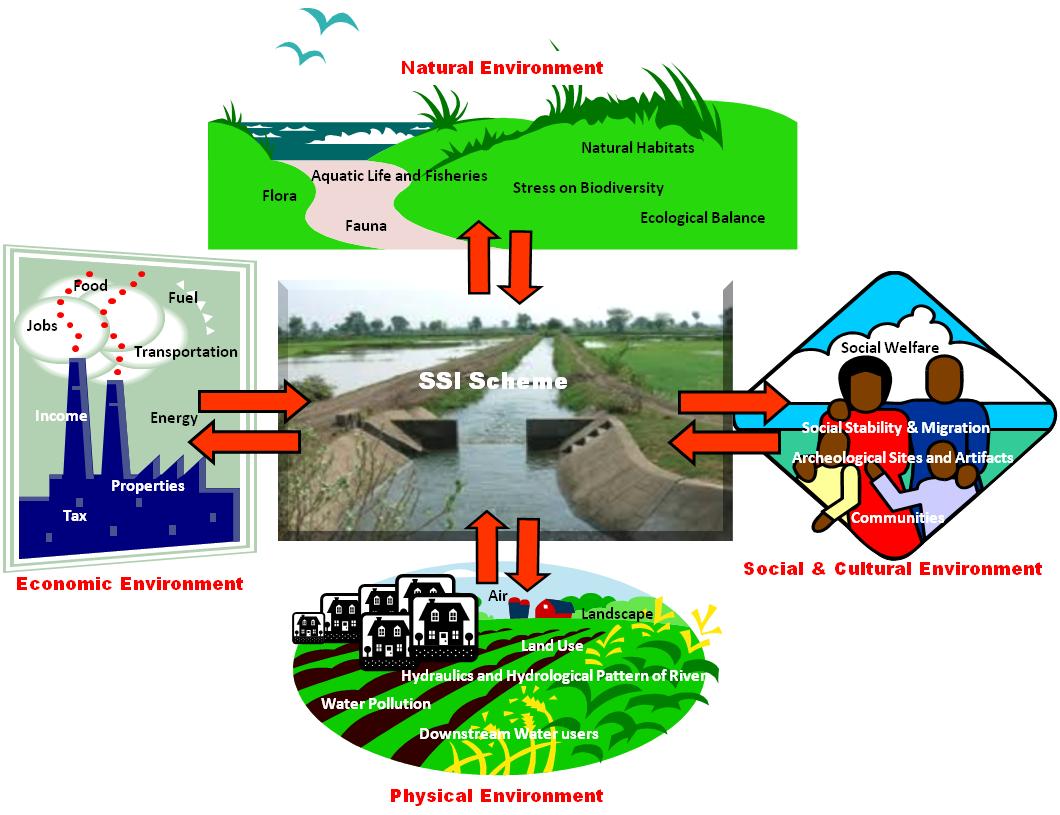 | Figure 1. A typical interface between a SSI scheme and the key elements of environment |
2.2. Project Context
The Mekabo SSI scheme is located about 50 km north of the city of Mekelle in Tigray region in Ethiopia. The main feature of the scheme includes a weir constructed across the Augla River to divert irrigation water to downstream command area. Figure 2 demonstrates the general view of the weir, which was funded, studied, designed, and constructed by the REST NGO in March 2016.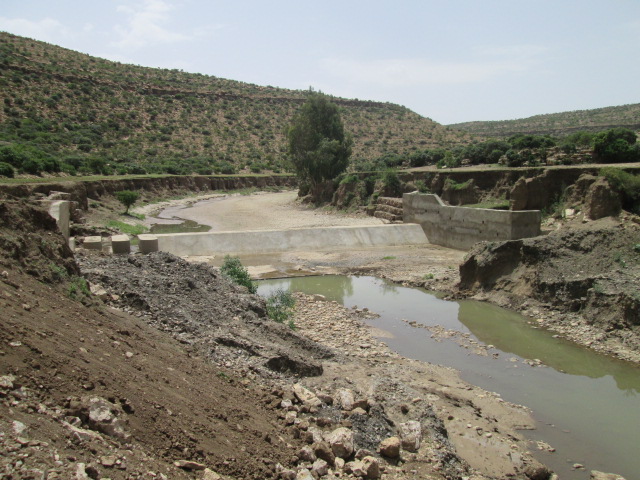 | Figure 2. Constructed weir to divert water to Mekabo small-scale irrigation scheme |
Figure 3 shows the aerial view of main canal and the 60 ha irrigation command area, which accommodates 144 smallholder farmers. The target command area is presently under rain-fed agriculture and is supposed to be transformed to irrigated agriculture immediately after the completion of 1.3 km long conveyance canal currently under construction by the same local NGO (REST) responsible for the construction of weir (Figure 4). With the fund donated by the local Orthodox Church and some additional contribution from the local community, farmers will construct the gravity distribution system shortly after the completion of conveyance canal. The present ESIA study is, in fact, a not binding independent investigation conducted by the experts of Tigray SMIS (Small-scale and Micro Irrigation Support) project apart from of any other study efforts made by the local institutions.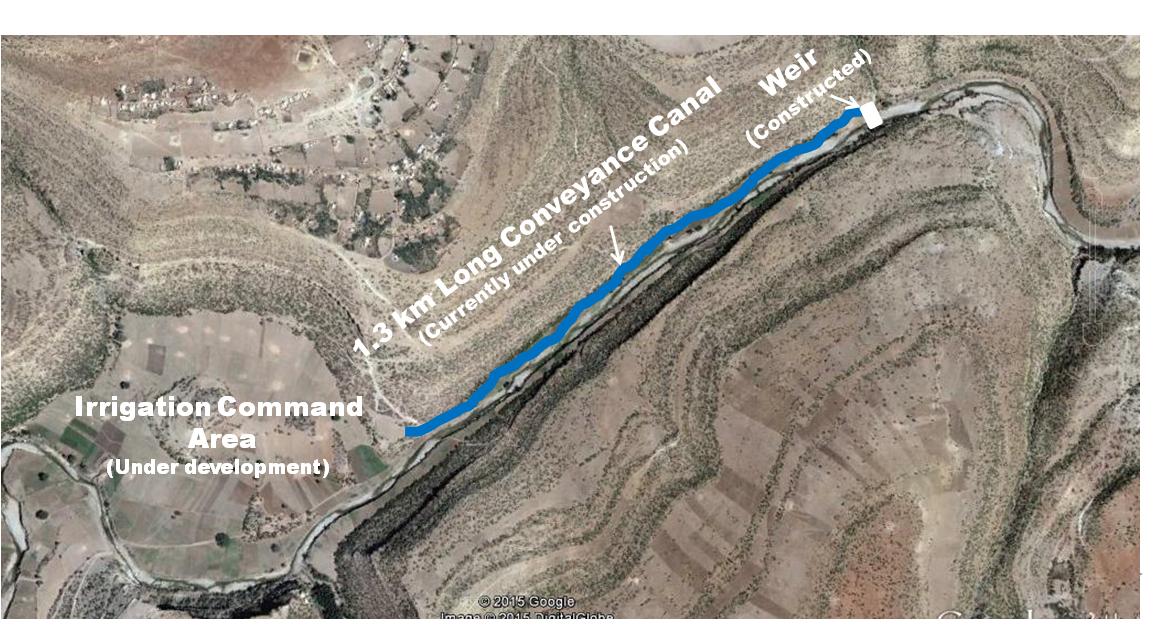 | Figure 3. The aerial view of Mekabo SSI scheme |
 | Figure 4. Mekabo scheme conveyance canal presently under construction |
2.3. Elaboration of Environmental Impact
The impact of a SSI scheme on the environment may take place at various stages of the life cycle of project mainly during construction phase, operation period, and decommissioning. Each of the major elements of the environment such as physical, natural, economic, and socio-cultural environment will be subject to interaction with SSI schemes as described in the following section. Figure 5 demonstrates the trend of temporal environmental impact of a typical SSI scheme including the Mekabo scheme at different stages of its life cycle. According to Figure 5, the environmental impact (positive and negative) would be initiated during construction phase (Line A). The impacts would then increasingly build up and continue during the operation period. The maximum impact, the highest point on line "B", may be observed after construction phase when the scheme reaches to its full operational capacity and remains almost constant throughout the rest of its operation period (Line C).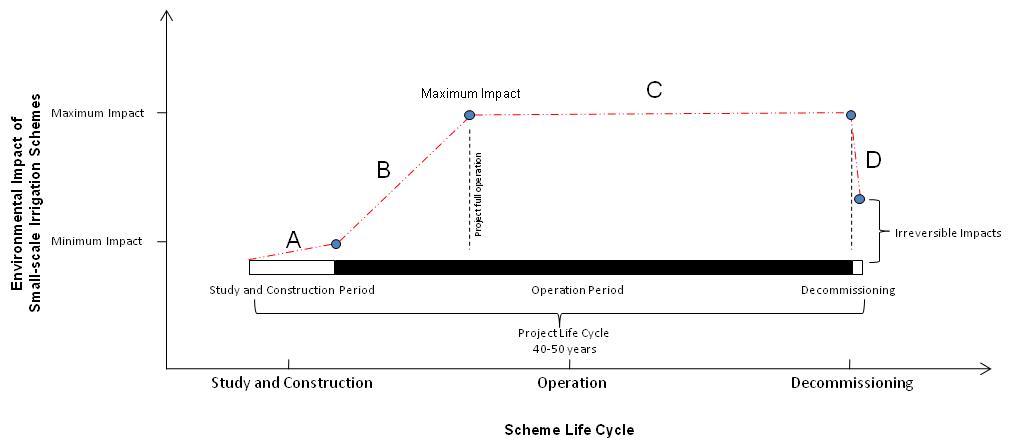 | Figure 5. Demonstration of temporal environmental impact of SSI schemes |
At the end of the life cycle of the scheme, as different components of the scheme is decommissioned, some of its impacts (positive and negative) would diminish and eventually reach to an inevitable and irreversible level where no known mitigation measure can compensate (Lower end of line D). The detailed impact of Mekabo SSI scheme on physical, natural, economic, and socio-cultural environment would be discussed as follows.
2.3.1. Physical Environment
The primary negative impact of Mekabo SSI scheme on the components of physical environment such as land, river, and air initiates during the construction of access roads to the quarry sites and project area. The other likely negative impacts, as indicated in Table 1, may take place during the other stages of the life cycle of project mainly during operation of weir, irrigation canals, structures as well as their decommissioning. The major positive impacts of the scheme constitute improvement in the state of land and water resources development. | Table 1. Major positive and negative environmental impact of Mekabo SSI scheme |
The remaining key negative impacts may mainly include disturbance of landscape, surface water, and air pollution, change in the hydraulics and hydrological pattern of river, change in the pattern of land use, and the likelihood of spread of Malaria as a result of accumulation of water in borrow pits.
2.3.2. Natural Environment
Very similar to physical environment, the likely impact of Mekabo SSI scheme on various components of natural environment could happen during various stages of life cycle of the scheme. As indicated in Table 2, the long-term impact on the natural environment mainly include change in the existing pattern of aquatic life and fisheries in the river, disturbance of existing ecological balance in the project area, interruption in natural habitats and the free movement of animals, and stress on biodiversity (flora, fauna). 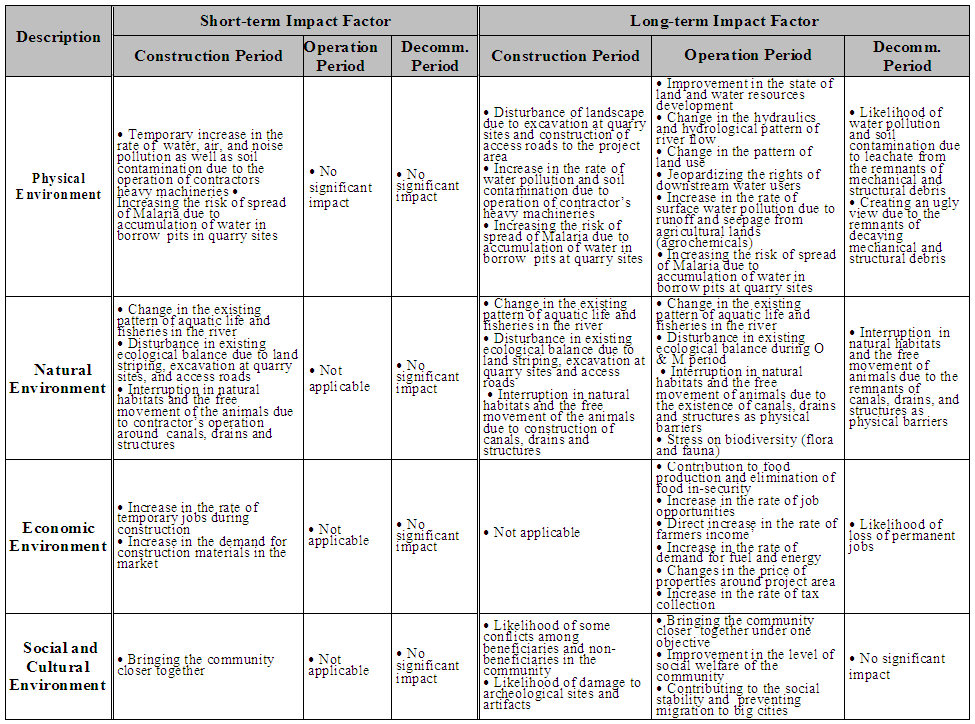 | Table 2. Major short-term and long-term environmental impact of Mekabo SSI scheme |
2.3.3. Economic Environment
The economic environment would bear the minimum negative impact from the implementation of Mekabo SSI scheme since the core objective of the project is to contribute to food production and to boost the local economic conditions. Therefore, most of the direct economic impacts presented in Table 3 are positive in nature and help to improve the income of farmers and promote further job opportunities. However, the major negative impacts (depicted in Table 1), would include the likelihood of loss of some permanent jobs after decommissioning of the project.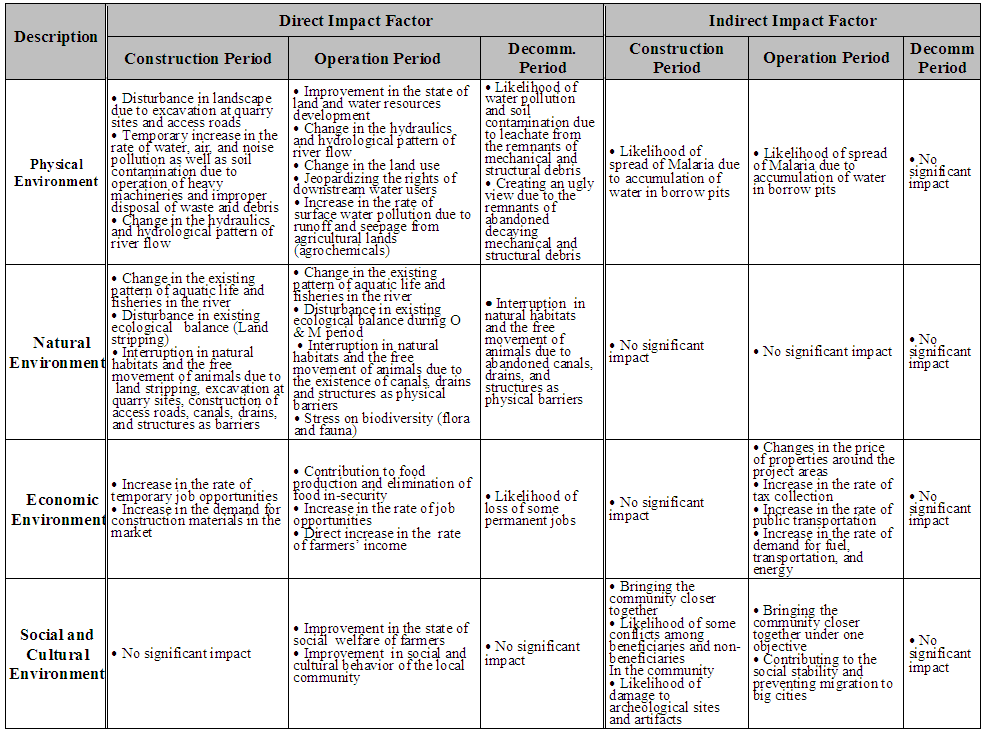 | Table 3. Major direct and indirect environmental impact of Mekabo SSI scheme |
2.3.4. Socio-Cultural Environment
The social and cultural environment may mostly endure the positive impact during the various stages of the life cycle of Mekabo SSI scheme. These have been summarized in Tables 1 and 4, which mainly include improvement in the social welfare of the farmers, contribution to the social stability of the region, and preventing migration to the big cities. However, on the other hand, implementation of a SSI scheme including the Mekabo scheme may trigger some conflicts between beneficiaries and non-beneficiaries, which have to be mitigated. The other likely negative social and cultural impact might include the likelihood of damage to archeological sites and valuable artifacts.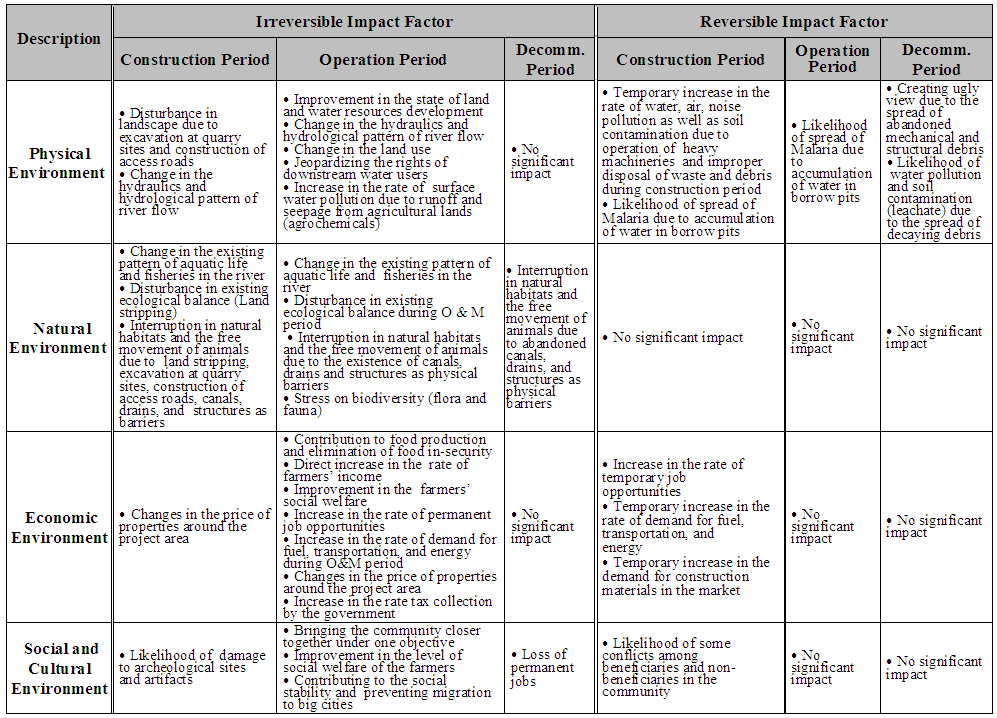 | Table 4. Major reversible and irreversible environmental impact of Mekabo SSI scheme |
2.4. Assessment
The major environmental impact assessment methods can be divided into five categories based on the way the assessment is conducted [8]:1. Ad hoc2. Overlays3. Checklists4. Matrices5. Networks Leopold et al. [9] were the first to suggest the use of matrix method for environmental impact assessment. Matrices are particularly useful as they reflect the impacts from series of interactions among the activities and the environmental elements [10]. Although, the Leopold matrix is believed to largely depend on the subjective evaluation of experts that allows the judgments be converted into empirical numbers, but it is still a valid and widely used approach for the assessment of environmental impact [11]. The initial classical Leopold matrix has 100 rows by 88 columns (8800 cells) and somewhat cumbersome to handle. In small-scale irrigation schemes, many of the impacts have trivial or no significant value. Therefore, in practice, attention should generally turn upon only a small subset of issues of overwhelming importance [6].A simplified two-dimensional matrix inspired by Leopold matrix has been adopted for the environmental and social impact assessment of Mekabo SSI scheme. Fourteen key impact factors have been singled out from a wider list of less significant potential factors. Each impact factor has been evaluated separately for its magnitude and significance using the indices presented in Tables 5 and 6. The assessment results have been presented in Table 7 where each cell is diagonally split in two parts. In the upper left-hand side of each box, a number from -1 to -10 has been included, which reflects the magnitude of impact, whereas number -10, as indicated in Table 5, represents the greatest magnitude and number -1 the least.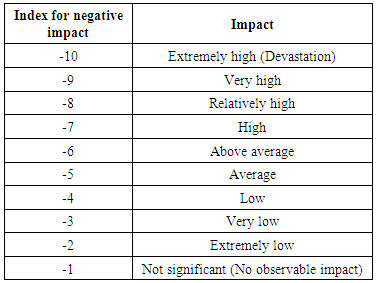 | Table 5. Ranking the magnitude of environmental impact |
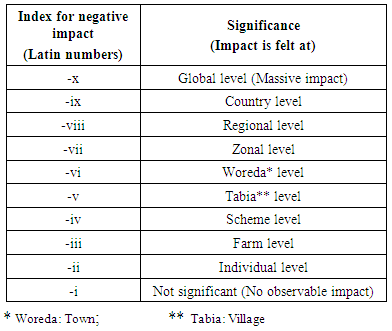 | Table 6. Ranking the significance of environmental impact |
The score for significance of each impact factor is placed in the lower right-hand side of each box, which according to Table 6 ranges from "-i" to "-x" (Latin numbers), with the same principle applied (The higher the value, the higher the significance). In addition to assigning the numerical values, a minus "-" sign has also been used to show that the assessment is for adverse direct, long-term, negative, and irreversible impacts. Under these conditions, the impact of Mekabo SSI scheme on physical, natural, economic, and socio-cultural environment has been assessed and presented in Table 7. To perform the assessment for Mekabo SSI scheme, fourteen-impact factors were listed in horizontal axis (j) and four assessment conditions in vertical axis (i). This two dimensional matrix, as could be viewed in Table 7, provides 56 cells, which accommodates all major environmental interactions for this scheme. The magnitude and significance of each impact factor has been weighed utilizing the information from field observation and expert judgment based on the indices presented in Tables 5 and 6. The last two columns in Table 7 present the sum of scores for magnitude (M) and significance (S) of each impact factor. The bottom row in Table 7 sums up the overall scores for both the magnitude and the significance.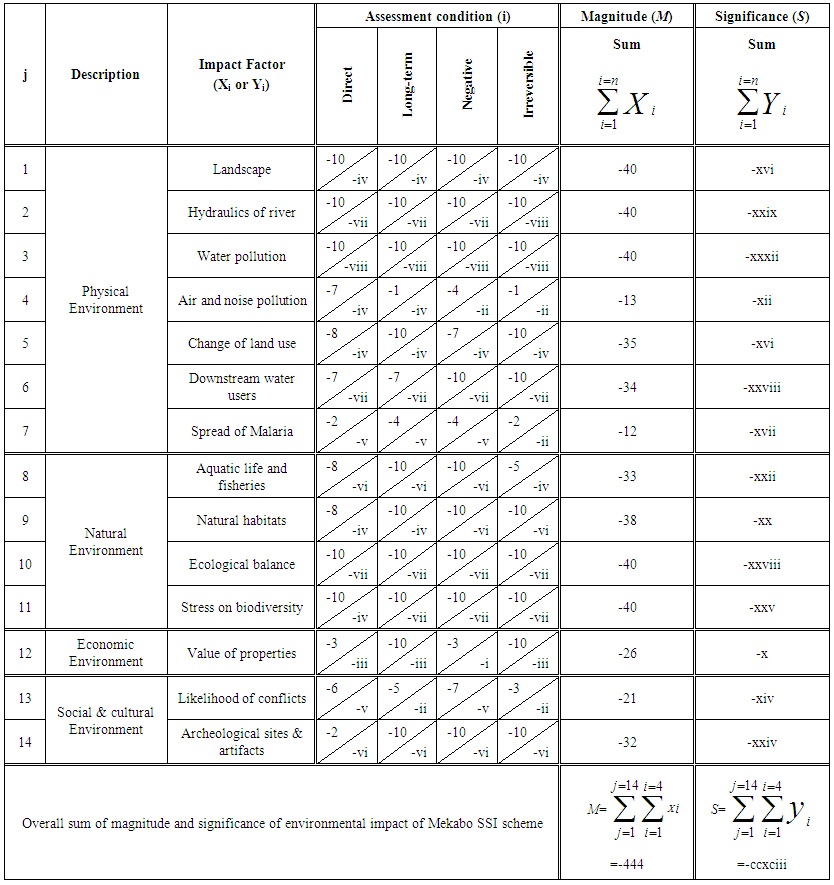 | Table 7. Assessing the magnitude and significance of environmental impact of Mekabo SSI scheme |
2.5. Analysis
2.5.1. Magnitude of Impact
The magnitude of each impact factor, as indicated before the last column in Table 7, could be obtained using the following equation:  | (1) |
Where:"X" represents the magnitude of impact factor; "i" is the counter for assessment condition (direct, long-term, negative, and reversible)."n" is the maximum number for assessment condition counter. Sum of the magnitude of each impact factor for condition "i" is calculated using eq. 2, where n=4. | (2) |
The overall sum of magnitude for impact factor "j" on condition "i" could be expressed as follows: | (3) |
Where:"j" is the counter for number of impact factors, which in the case of Mekabo SSI scheme is 14. Substituting for m (m=14) in eq. 3, the overall magnitude of environmental and social impact of Mekabo SSI scheme has been estimated using the following expression:  | (4) |
2.5.2. Significance of Impact
The significance of each impact factor for condition "i" (direct, long-term, negative, and reversible), as indicated in the last column in Table 7, could be defined using the following equation: | (5) |
Where:"Y" represents the significance of environmental impact. Table 7 shows the sum of the significance of each impact factor for condition "i" using eq. 6 (n=4): | (6) |
The overall sum of significance of impact factor "j" for condition "i" has been determined using equations 7 and 8 after substituting for "j" (m=14): | (7) |
 | (8) |
3. Discussion
The sheer assessment of environmental impact does not provide adequate evidence to decide the fate of a SSI scheme. Therefore, some threshold values will be required to be able to evaluate the magnitude and significance of the impact. Using the expert judgment the acceptable and rejecting thresholds for both magnitude (Ma, Mr) and significance (Sa, Sr) of environmental impact of Mekabo SSI scheme have been defined and presented at the bottom row of Tables 8 and 9. Under an ideal condition, the lowest acceptable threshold for the magnitude of environmental impact of Mekabo scheme (Ma), as presented in Table 8, would be as follows: | (9) |
However, the Mekabo SSI scheme could be rejected if under a worse scenario the magnitude of its impact (Mr) indicated in the last row in Table 9, increases beyond -479 as expressed in eq. 10: | (10) |
With the two above thresholds (Ma, Mr), the sheer magnitude of environmental impact of Mekabo SSI scheme presented in Table 7 (M), could now be compared against these two thresholds as depicted in eq. 11:  | (11) |
Substituting eq. 9 and 10 into eq. 11, the following equation would emerge: | (12) |
Likewise, in order for significance of environmental impact of Mekabo SSI scheme be acceptable, its score could be equal or above the Latin number "-cxxxii" (Table 8) as indicated in the following expression: | (13) |
Nevertheless, the implementation of Mekabo SSI scheme may be rejected if its significance score crosses beyond "-ccclii" score (Table 9) as presented in eq. 14: | (14) |
Again, the two above thresholds would provide adequate input to be used in eq. 15 to be able to evaluate the significance of environmental impact of Mekabo SSI scheme.  | (15) |
Substituting eq. 13 and 14 into eq. 15, the following equation will emerge: | (16) |
 | Table 8. Defining the acceptable threshold for environmental impact of Mekabo SSI scheme |
4. Conclusions
According to Table 7, the overall sum of magnitude score for environmental and social impact of Mekabo SSI scheme (M) is equal to "-444". It could be viewed in eq. 17 that this value lies between the two estimated acceptable (-105) and rejecting thresholds (-479) emerged from Tables 8 and 9.  | (17) |
Similarly, the overall sum of significance score for environmental and social impact of Mekabo SSI scheme (S) presented in Table 7, is equal to "-ccxciii". Equation 18 illustrates the fact that this estimated figure also lies between the two acceptable and rejecting thresholds obtained from Tables 8 and 9.  | (18) |
Therefore, as summarized in Table 10, since the magnitude and significance scores for environmental and social impact of Mekabo SSI scheme lies between the two extreme thresholds and does not cross beyond the rejecting threshold, it may be concluded that the irrigation scheme can be implemented provided that the mitigation measures suggested in the next section addressing the adverse negative impacts be properly implemented.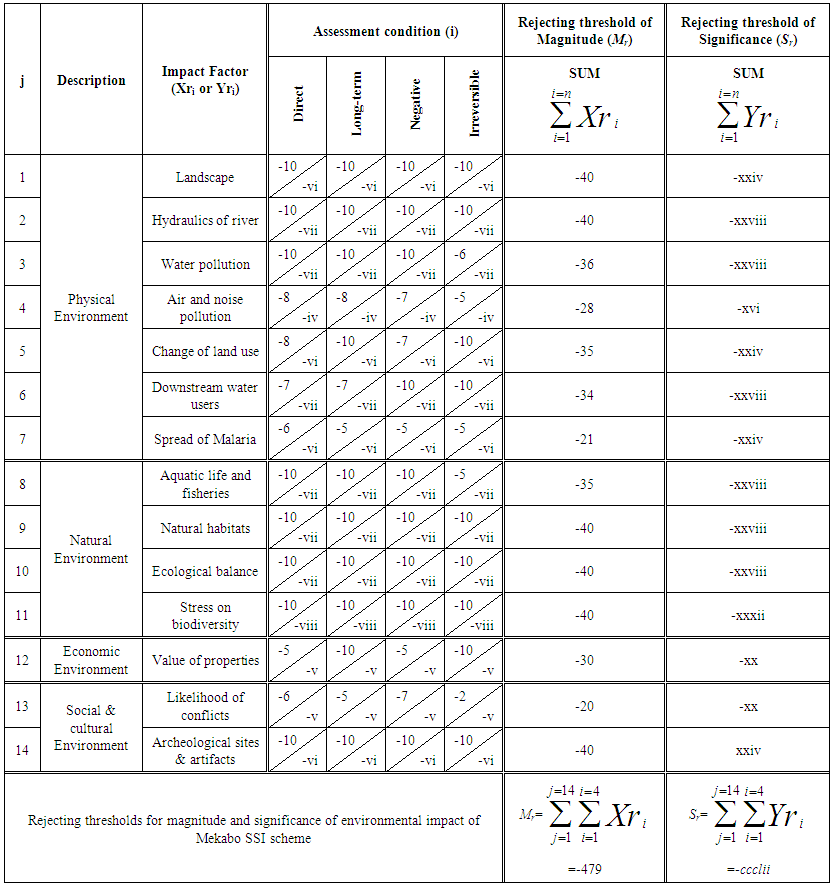 | Table 9. Defining the rejecting threshold for environmental impact of Mekabo SSI scheme |
 | Table 10. Summary of analysis for Mekabo SSI |
5. Mitigation Measures
Implementation of any SSI scheme including Mekabo scheme may leave behind some negative and irreversible impacts that could not be mitigated with any known mitigation measures. Therefore, during environmental impact assessment, the environmentalists should interact with the study and design teams in order to introduce and discuss any environmentally viable alternatives. These alternatives may include among others the alternative sites and alternative project components as well as different products, materials, and technologies [12]. Even the “No Project” alternative, which implies maintaining the existing land and water resources status quo, is often promoted by some strict environmentalists. However, in case of Mekabo SSI scheme, the "No Project" alternative proves to be in contradiction with the food security strategy of government of Ethiopia. In reality, the positive economic and social impact of Mekabo SSI scheme could partially offset some of its negative impacts since the scheme promotes increased household income, increased employment opportunities, improved food security, contribution to social stability, and prevention of migration of farmers to the big cities. Substantiating the above-mention argument, many developers and policy makers consider the ‘No Alternative’ as an unrealistic alternative [12]. The measures summarized and presented in Table 11 covers the range of mitigations intended to reduce the negative and reversible impacts of Mekabo SSI scheme at study, construction phase, operation period, and decommissioning. If the mitigations were being applied after all components of the project have already been constructed, the maximum adverse impact would occur during operation period (Upper end of line B in Figure 6) and it would be much more difficult and more costly to apply the mitigation measures at this stage (Line F). However, if the authorities initiate early application of mitigation measures (Line E), the negative and reversible impacts could better be managed at the earlier stage of operation period.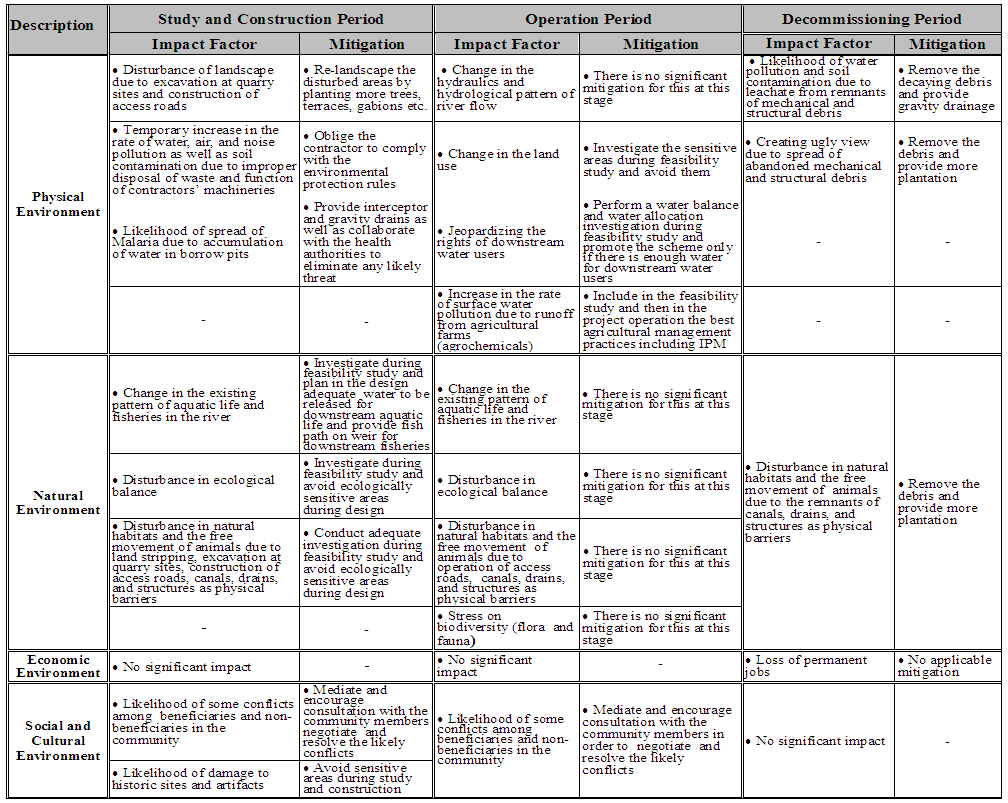 | Table 11. Summary of major mitigation measures to reduce the negative environmental impact |
 | Figure 6. Demonstration of timely application of mitigation measures in SSI schemes |
6. Conclusions
a. A simplified environmental and social impact assessment approach was developed using a two dimensional matrix and expert judgment inspired by Leopold matrix.b. The developed approach was applied to assess the impact of Mekabo SSI scheme on four major elements of environment including physical, natural, economic, and socio-cultural environment. c. Fourteen factors for Mekabo small-scale irrigation scheme were identified as the major susceptible elements for which the environmental impact during construction phase, operation period, and decommissioning were assessed. d. The acceptable and rejecting thresholds were defined to produce a platform for comparison of magnitude and significance of the impacts.e. The analysis of the result of assessment shows that the scores of Mekabo SSI scheme lie between the two acceptable and rejecting thresholds; thus, could be implemented with some mitigations. f. Some mitigation measures were also suggested to reduce the major negative and reversible environmental impact of the scheme.
ACKNOWLEDGEMENTS
The authors would like to express their gratitude to the Embassy of the Kingdom of the Netherlands (EKN) and Agriteam Canada Consulting Ltd. in Ethiopia as the owner of the intellectual property of the SMIS Project for the opportunity to publish this paper.
References
| [1] | Clark B. D., R. Bisset, A. Gilad, P. Tomlinson (1984). Center for environmental management and planning, University of Aberdeen. D. Reidel publishing company. |
| [2] | Anonymous (1996). Environmental impact assessment and environmental auditing in the pulp and paper industry. FAO Forestry paper 129. |
| [3] | Dougherty T.C., A. W. Hall, H. R. Wallingford (1995). Environmental impact assessment of irrigation and drainage projects. FAO Irrigation and Drainage Paper 53. Food and Agriculture Organization of the United Nations. |
| [4] | Ulsido M. D., E. A. Demisse, M. A. Gebul, and A. E. Bekelle (2013). Environmental impacts of small-scale irrigation schemes: Evidence from Ethiopian Rift Valley Lake Basins. Environmental Research, Engineering and Management, 2013. No.1(63), P.17-29. |
| [5] | Josimovic B., J. Petric, and S. Milijic (2014). The use of the Leopold matrix in carrying out the EIA for wind farms in Serbia. Energy and Environment Research; Vol. 4, No. 1. |
| [6] | Wathern P. (2004). Environmental impact assessment. Theory and practice. Taylor & Francis Group e-Library. |
| [7] | Anonymous (1981). Environmental impact assessment methodologies description and analysis and first approach to environmental impact assessment methodologies application. In: Development and application of appropriate environmental impact assessment and management methodologies, Río de Janeiro. |
| [8] | Warner M. L. and E. H. Preston (1974). A review of environmental impact assessment methodologies. Office of research and development, US Environ Protection Agency. Washington, D.C. 20460. |
| [9] | Leopold, L. B., F. E. Clarke, B. B. Hanshaw, and J. R. Balsley (1971). A procedure for evaluating environmental impact. United States Department of the Interior. Geological Survey Circular 645. Washington, D.C. |
| [10] | Ponce V. M. (2009). The Leopold matrix for evaluating environmental impact. ponce.sdsu.edu/the_leopold_matrix.html. |
| [11] | Gilpin A. (2000). Environmental impact assessment. Cambridge university press. The Edinburgh building, Cambridge CB2 2RU, United Kingdom. |
| [12] | Oroda A. S. (2015). Small-scale Irrigation and Agricultural Value Chain for Food Security Project -Kenya (SIAVCFSP). The environmental and social assessment report. African Development Bank group. |






































 Abstract
Abstract Reference
Reference Full-Text PDF
Full-Text PDF Full-text HTML
Full-text HTML